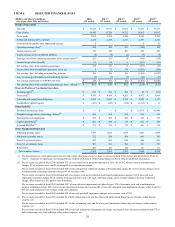Albertsons 2016 Annual Report Download - page 23
Download and view the complete annual report
Please find page 23 of the 2016 Albertsons annual report below. You can navigate through the pages in the report by either clicking on the pages listed below, or by using the keyword search tool below to find specific information within the annual report.21
Operations at many of the Company’s facilities require the treatment and disposal of wastewater, storm-water and agricultural
and food processing wastes, the use and maintenance of refrigeration systems, including ammonia-based chillers, noise, odor
and dust management, the operation of mechanized processing equipment, and other operations that potentially could affect the
environment, health and safety. Some of the Company’s facilities have been operating for many years, and were built before
current environmental standards were imposed, and/or in areas that recently have become subject to residential and commercial
development pressures. Failure to comply with current and future environmental, health and safety standards could result in the
imposition of fines and penalties, and the Company has been subject to such sanctions from time to time. New environmental,
health and safety requirements, stricter interpretations of existing requirements, or obligations related to the investigation or
clean-up of contaminated sites, may materially affect the Company’s business or operations in the future.
Real or perceived food quality and food or drug safety issues and related unfavorable publicity could adversely affect
the Company’s operating results and reputation.
There is increasing governmental scrutiny, regulations and public awareness regarding food quality and food and drug safety.
The Company may be adversely affected if consumers lose confidence in the safety and quality of the Company’s food and
drug products. Any events that give rise to actual or potential food contamination, drug contamination or food-borne illness or
injury, or events that give rise to claims that the Company’s products are not of the quality or composition claimed to be, may
result in product liability claims from individuals, consumers and governmental agencies, penalties and enforcement actions
from government agencies, a loss of consumer confidence and harm to the Company’s reputation. In addition, adverse publicity
about these types of concerns, whether valid or not, may discourage consumers from buying the Company’s products or cause
production and delivery disruptions, which may adversely affect the Company’s financial condition and results of operations. It
may be necessary for the Company to recall unsafe, contaminated or defective products. Recall costs and product liability
claims can be material. While the Company generally seeks contractual indemnification and insurance coverage from its
suppliers, it might not be able to recover these significant costs from its suppliers.
The Company’s businesses may become subject to legal proceedings that may adversely affect the Company’s financial
condition and results of operations.
The Company’s businesses are subject to the risk of legal proceedings by employees, unions, consumers, customers, suppliers,
stockholders, debt holders, governmental agencies or others through private actions, class actions, administrative proceedings,
regulatory actions or other litigation or proceeding. The outcome of litigation, particularly class action lawsuits and regulatory
actions, is difficult to assess or quantify. Plaintiffs in these types of lawsuits may seek recovery of very large amounts, and the
magnitude of the potential loss relating to such lawsuits may remain unknown for substantial periods of time. The cost to
defend future litigation may be significant. There may also be adverse publicity associated with litigation that may decrease
consumer confidence in the Company’s businesses, regardless of whether the allegations are valid or whether the Company is
ultimately found liable. As a result, litigation may adversely affect the Company’s financial condition and results of operations.
See also “Item 3 Legal Proceedings” below.
Efforts to reduce pharmacy reimbursement levels and alter health care financing practices may adversely affect the
Company’s results of operations.
The continued efforts of health maintenance organizations, managed care organizations, pharmacy benefit managers,
government entities and other third party payors to reduce prescription drug costs and pharmacy reimbursement rates may
impact the Company’s profitability. In particular, increased utilization of generic pharmaceuticals (which normally yield a
higher gross profit rate than equivalent brand named drugs) has resulted in pressure to decrease reimbursement payments to the
Company’s pharmacies for generic drugs, causing a reduction in the Company’s generic profit rate. Additionally, there has been
significant consolidation within the generic manufacturing industry, and it is possible that this and other external factors may
enhance the ability of manufacturers to sustain or increase pricing of generic pharmaceuticals and diminish the Company’s
ability to negotiate reduced acquisition costs. Any inability to offset increased costs or to modify the Company’s activities to
lessen the impact could have an adverse effect on the Company’s results of operations.
In addition, during the past several years, the United States health care industry has been subject to an increase in governmental
regulation and audits at both the federal and state levels. Efforts to control health care costs, including prescription drug costs,
are continuing at the federal and state government levels. Changing political, economic and regulatory influences may
significantly affect health care financing and reimbursement practices. A change in the composition of pharmacy prescription
volume toward programs offering lower reimbursement rates could negatively impact the Company’s profitability. The Patient
Protection and Affordable Care Act made several significant changes to Medicaid rebates and to reimbursement. One of these
changes was to revise the definition of the Average Manufacturer Price, a pricing element common to most payment formulas,
























